The history of Psychiatry: Etiology of madness: Sin
|
Historically, the majority view of the cause of insanity and mental illness was sin, life choices, life situations, but not a bodily disease. |
|
|
In 1803, Christian Reil suggested that the Cat Piano was the cure for insanity. It worked by seating the insane in front of the Cat Piano, as someone played, sanity would be restored. Reil suggested this clever and imaginative hyperbole, in order to drive home his point, that insanity was a spiritual problem not a bodily problem. |
|
|
Doctors before the 19th century, knew less than a typical thirteen year old today, who dissected a few raccoons on his back yard picnic table and experimented with his chemistry set he got for Christmas! |
|
|
|
|
|
|
|
Introduction:
- The majority view of history for the cause of insanity, has always been sin and life choices, not the body. Here is the master summary of the historical Survey of Mental illness etiology 1500 - 1900
- Historically, there were three groups of etiologies for insanity: 1. Those who believed sin directly caused insanity. 2. Those who believed sin indirectly caused insanity by first producing melancholy blood, which then caused insanity. 3. Those who believed insanity was a random bodily illness (like chemical psychiatrists today), were a small minority.
- Historically, it was pagans and non-Christians who viewed the cause of insanity as biologic. Christians have always viewed the cause of insanity is life choices, sin and moral violations of the conscience.
- A shocking number of Christians today, have believed the lies told them by chemical psychiatrists. This change took place in the last 25 years. Christians today commonly believe what the media tells them, that "mental illness is a serious medical problem with their brain", that "neuroleptic drugs correct chemical imbalances the same way insulin corrects diabetes". Its time for Christians to wake up the fact that they have been under attack by the devil through the hands of chemical psychiatrists who are usually atheists who promote naturalistic evolution.
A. Psychiatric historians re-write history:
- Telling only half the truth of history, while leaving out the other half, is a clever way re-writing history, but it often misleads the readers to false conclusions as to the way things really were.
- Most histories of psychiatry are written by chemical psychiatrists who believe insanity is caused by bad genes and chemical imbalances in the brain. Their only cure are drugs. Their histories are slanted, biased and a dishonest representation of the facts. In a re-writing of history, they will portray the biologic view as that which dates back to Hippocrates.
- For example, history books on psychiatry will gush over Benjamin Rush, as the "father of modern psychiatry", and how he believed insanity was caused by bloated blood vessels. But they rarely tell you that Rush devotes an entire section in his book to, "The causes which induce intellectual derangement, by acting upon the body through the medium of the mind". In other words, Rush believed that insanity was caused by the mind, which then effected the body: Some of his causes of insanity are: "A conscience burdened with guilt, extravagant joy, terror, fear, public humiliation, homesickness, unexpected losses of money, drawing high prizes in a lottery, intense study, memorization." Wow! does that sound like the Benjamin Rush they taught you about in University? Not likely! They kind of skipped that important information! But now you know, and that is why you need to read everything we write!
- We offer Nicholas Robinson as another example of this dishonest and slanted historical scholarship. There are many, many more. You will notice that Allan Ingram, in his Patterns of Madness in the Eighteenth Century, 1998 AD, makes it appear like Robinson believed in a chemical/biologic etiology of insanity ... just like Allan Ingram himself. In fact, Robinson believed that sin and life choices and circumstances had a direct effect on the human body, which then in turn, caused insanity.
- Re-writing of history by Allan Ingram: "Nicholas Robinson: ... His adoption of a rigorously 'mechanical' view of mental illness shows the powerful influence of Willis, whose 'Animal Spirits' become in Robinson the `Alachinulae' of the fibres of the brain in their relation to the nervous system and to the entire animal economy. ... Robinson takes madness seriously. That is, he does not explain the experiences and sufferings of the mad as delusions, products of a disordered imagination. They are real for the simple reason that they are bodily in origin." (Patterns of Madness in the Eighteenth Century, A Reader, Allan Ingram, 1998 AD, p76)
- True history: In 1729 AD, Nicholas Robinson, doctor and governor of Bedlam the same time James Monro, believed insanity was caused by life choices, sin and thinking too hard, over excitement of emotion, so as to break the nerves of the brain, "all the Decays of the Nerves and Lownesses of the Spirits are mechanically accounted for" ... "Fits had so weakened the Fibres of the Optic Nerves." Its like trying to put too much current through an electrical wire and it either melts or blows a fuse! Robinson does take a biologic view of the etiology of mental illness, but he believes it is a case of the choices, thoughts and emotions of the mind that is ultimately responsible for the damage. He notes how damaged nerves can be caused by sin and guilt: "Hence arise their Difference, Scruples, and Fears, concerning the Sincerity of their Faith and Repentance, as also the Certainty of their Election or Reprobation; which several Points, from the preaching of some hot-headed Gospel-Ministers, are so strongly fix'd on the Minds of silly, weak, unhappy People, as to work them into a State of Despondency. THEN their Sins fly glaringly in their Faces, and are so infinitely great, that no Satisfaction can compensate; then they think of nothing but the fearful Wrath of God just ready to be pour'd out upon them; that the Sentence of Condemnation is already pass'd, and that they certainly shall be damn'd to all Eternity." Nicholas Robinson believed that mental illness was caused by feelings of sin, hopelessness and condemnation which in turn damaged the brain nerves. (A New System of the Spleen, Nicholas Robinson, 1729 AD)
- Historical Survey of Mental illness etiology 1500 - 1900
B. Johann Heinroth's etiological summary in 1818 AD:
- This historic document is an excellent summary of all the historic views of what caused insanity. Remember that humoral medicine was practiced up to 1858 AD. Heinroth himself, believes that insanity is caused by sin.
- "Remorse; hasty vows; temptation; fanaticism; political revolutions; good or bad luck; nostalgic memories of a happy past; disappointed hopes; gambling; unhappy love; poor marital and economic conditions; shame; fear; fright; anger; studying objects which vividly excite the imagination; insomnia; immoderate exercise; long-lasting periods of repose; hunger; loss of blood; drunkenness; sunstroke; effect of the moon; cold; suppressed sweating; unsatisfactory sexual life; onanism; excessive sexual activity; arrested lactation; diseases of the abdomen, especially diseases of the bile; flatulence; worms; earlier diseases such as intermittent fever; present diseases; inflammation of the brain; apoplexy; catalepsy; teething difficulties; colic; acute dysentery; erysipelas; latent acute and chronic skin rash; suppression of natural blood evacuations; pellagra; plica polonia cropped short; abscesses healed too quickly; head injuries; insects; persistent exhaustion following convalescence; medicaments; so-called love potions; associating with the insane." (Textbook of Disturbances of Mental Life and Soul, Johann Heinroth, 1818 AD)
- Historical Survey of Mental illness etiology 1500 - 1900
C. The Humoral etiology: Melancholy blood, bad nerve fibers & spleens
- The Humoral era (450 BC - 1858 AD). The idea that insanity was caused by "bad blood" dates back to Hippocrates, the quack we can thank for misleading the world for 2500 years. Medical science before the modern era (1858) was utter quackery! The humoral theory of the four body fluids: bile, phlegm and blood etc. were wrongly believed to the cause of all illnesses, including mental illnesses. The result was blistering, bloodletting and induced vomiting to remove these bad fluids from the body.
- Humoristic theory gave way to the discovery of the cell by Rudolf Virchow's in 1858 AD. The discovery of the cell, germs put the wooden stake into the heart of Hippocratic medicine ... this is the guy who created the "Hippocratic oath to do no harm"! Good riddance.
- A key point all chemical psychiatric historians fail to notice, is that doctors believed that sin, life choices and conflicts of conscience made the body sick (melancholy blood), which then led to insanity.
- Chemical psychiatric historians have nothing to gain, and everything to lose, if they admit that the until the 1950's, almost everyone believed insanity was caused by moral choices, not broken bodies.
- It is important that a good number of doctors rejected altogether the idea that the body caused in sanity. Historically, those who viewed insanity was caused by a biological cause, like Melancholy blood, the spleen, the stomach, bad nerves or blood vessels in the brain, actually believed that sin, life choices and conflicts of conscience made the body sick.
- So historically, it was a tiny minority who believed the same as chemical psychiatrists today, that insanity was caused by the body alone.
- Historically, there were two different sets of views regarding sin, guilt and violating the conscience as a cause of insanity: 1. Those who believed that sin directly caused insanity without affecting the body at all. 2. Those who believed that sin affected the body by producing melancholy blood, which then caused insanity. This explains why vomits, the swing, bloodletting etc were practiced by those who viewed the cause of madness as sin.
- Historically, there were three groups of etiologies for insanity: 1. Those who believed sin directly caused insanity. 2. Those who believed sin indirectly caused insanity by first producing melancholy blood, which then caused insanity. 3. Those who believed insanity was a random bodily illness (like chemical psychiatrists today), were a small minority.
- In the pre-scientific humoristic era, some "mad doctors" claimed many biological causes, but they were all wrong. As we enter the modern era of science where humoristic theory gave way to the discovery of the cell by Rudolf Virchow's in 1858 AD, medicine has increased its knowledge and curing of real disease. Psychiatry, on the other hand, has made absolutely no progress like real medicine. The science of psychiatry today, is in fact identical to the mad doctors of Bedlam in 1750 AD. Today's psychiatrists have no more idea about the etiology or cure of mental illness then their mad doctor colleagues three centuries before them. Neither have any idea what causes mental illness and neither have any cures to offer.
- Historically, mental illness was seen to be caused by sin, guilt and a bad conscience. This is the correct view and it was the majority view for at least the last 500 years!
- Historical Survey of Mental illness etiology 1500 - 1900
D. The Humoral etiology: bad nerve fibers
- As the title of Nicholas Robinson's paper says, "Wherein all the Decays of the Nerves, and [madness is] mechanically Accounted for" Robinson takes the indirect biologic view of the etiology of mental illness. He views sin and life choices and circumstances as the cause, which damages the nerves, which then causes madness. He notes that environment, whether you are an atheist, or Christian, it makes a difference. He views that the bad nerve fibres can be aggravated by feelings of condemnation. He notes that if someone with the chemical foundation (bad nerve fibres) to trigger mental illness is present, that exposure to "hellfire and Brimstone" preaching will make the melancholy worse than if he had never been exposed to such preaching. Since Robinsons somatic origin of mental illness was totally wrong, what we are left with is the environmental etiology: feelings of condemnation for sin. This means that Robinson's actual observations were correct. What he could not observe (somatic origin) was not correct. The same is true with modern psychiatry. In summary, Nicholas Robinson believed that mental illness was caused by bad brain nerves, but was also affected by one's feelings of sin and condemnation.
- William Battie adopted Nicholas Robinson's etiology of bad nerves caused by sin and life choices and circumstances as the cause. Battie modified this a bit and believed that madness sometimes had an organic cause and sometimes a spiritual cause. "From whence we may collect that Madness with respect to its cause is distinguishable into two species. The first is solely owing to an internal disorder of the nervous substance: the second is likewise owing to the same nervous substance being indeed in like manner disordered, but disordered ab extra [from outside]; and therefore is chiefly to be attributed to some remote and accidental cause. The first species, until a better name can be found, may be called Original, the second may be called Consequential Madness." (A Treatise on Madness, William Battie, 1758 AD, p 44)
- Historical Survey of Mental illness etiology 1500 - 1900
E. Mental illness is caused by guilt of unrepented sin, fear of going to hell:
- "THERE is a very great difference between such as are only under trouble of Conscience, and such whose Bodies are greatly diseased at the same time: A sense of Sin, and great sorrow for it ... great distress of Conscience for many Months, and under a continued fear and apprehension of God's displeasure ... From their Apostacy [falling away from Christianity] we may derive all our miseries; both the pains and sicknesses that afflict our Bodies, and the fears and terrors that overwhelm our Souls." (A Discourse Concerning Trouble of Mind and the Disease of Melancholly, Timothy Rogers, 1691 AD)
- "Hence arise their Diffidence, Scruples, and Fears, concerning the Sincerity of their Faith and Repentance, as also the Certainty of their Election or Reprobation; which several Points, from the preaching of some hot-headed Gospel-Ministers, are so strongly fix'd on the Minds of silly, weak, unhappy People, as to work them into a State of Despondency. THEN their Sins fly glaringly in their Faces, and are so infinitely great, that no Satisfaction can compensate; then they think of nothing but the fearful Wrath of God just ready to be pour'd out upon them; that the Sentence of Condemnation is already pass'd, and that they certainly shall be damn'd to all Eternity." (A New System of the Spleen, Nicholas Robinson, 1729 AD)
- "take a view of the Atheist or Libertine under the same Affliction. What Hope, what Refuge can he expect from a gracious God, whose Providence he has so often blasphem'd, ridicul'd and deny'd? Under the Symptoms of religious Melancholy, the Mind was in Despair through Doubt; but here, even that Doubt would be the highest Pleasure: He now perceives God's heavy Wrath ready to be executed upon him, and thinks he is already in Hell; himself is Hell, and suffers all the Pains of the Damn'd; he howls, he roars, and, in the Height of his outrageous Frenzy, blasphemes God and his Religion: Where can he rest his hopeless Hope! where seek for Mercy, when Conscience, Horror, Despair, and all the dismal Scenes of Woe, that can afflict the most obdurate Heart, fly glaringly in his Face, and sting his tortur'd Soul, with Pain and Grief unsufferable to human Nature! Hence spring those frequent Suicides, to which these harden'd Miscreants have Recourse, to rid them of a Life most loathed, wretched, and miserable to endure. So that no Scene of Horror can be more dreadful, than to view an Atheist on his Bed of Sickness, just reviving to a Sense of his being forsaken of God, and all Hopes of his Mercy." (A New System of the Spleen, Nicholas Robinson, 1729 AD)
- "And, indeed, Inward Tenors, are things that may he sadly felt; but they cannot be fully express'd. To have the sense of Tormenting, Racking Pain, the immediate prospect of Death, and together with this, an apprehension of God's Displeasure, and the fear of being cast out of his Glorious Presence for ever, this was a part of my Case; And who can describe that Anguish and Tribulation, which such apprehensions cause in a desolate and a mourning Soul!" (A Discourse Concerning Trouble of Mind and the Disease of Melancholly, Timothy Rogers, 1691 AD)
- Sinful cares and lusts of this world: "SINFUL Impatience, Discontents and Cares, proceeding from a Sinful Love of some bodily Interest, and from want of sufficient Submission to the will of God, and Trust in him, and taking Heaven for a satisfying Portion. This is one of the most common Causes. I must necessarily use all these words to shew the true Nature of this complicate Disease of Souls. The Names tell you that it is a Conjunction, of many Sins, which in themselves are of no small malignity; and were they the Predominant Bent and Habit of Heart and Life, they would be the signs of a graceless State: But while they are hated and overcome not Grace, but our Heavenly Portion is more esteemed, and chosen, and sought, than earthly Prosperity, the mercy of God through Christ doth pardon it; and will at last deliver us from all. But yet it beseemeth, even a pardoned Sinner to know the Greatness of his Sin, that he may not favour it, nor be unthankful for Forgiveness. I will therefore distinctly open the Parts of this Sin, which bringeth many into dismal Melancholy." (The Signs and Causes of Melancholy, Richard Baxter, 1670 AD)
- Historical Survey of Mental illness etiology 1500 - 1900
F. Mental illness is caused by high self-esteem, loving the world, selfishness, debt problems:
- Money and debt problems: "WHEN Men have not themselves only, but Wives and Children in want to quiet. AND when they are in Debt to others, which is an heavy Burden to an Ingenious Mind; tho' Thievish Borrowers make too light of it. In these Straits and Trials Persons are apt to be too sensible and Impatient, when Creditors are calling for their Debts, and they have it not to pay them, it's hard to keep all this from going too near their Heart, and hard to bear it with obedient quiet Submission to God; especially for Women, whose Nature is weak, and liable to too much Passion." (The Signs and Causes of Melancholy, Richard Baxter, 1670 AD)
- Loving self and the world to much: "AND the secret Root or Cause of all this, is the worst Part of the Sin, which is too much Love to the Body and this World. Were nothing over-loved, it would have no Power to Torment us; if Ease and Health were not over-loved, Pain and Sickness would be the more Tolerable; if Children and Friends were not over-loved, the Death of them would not overwhelm us with immoderate Sorrow; if the Body was not over-loved, and worldly Wealth and Prosperity over-valued, it were easie to endure hard Fare and Labour, and Want, not only of Superfluities and Conveniences, but even of that which is necessary to Health, yea, or Life it self, if God will have it so, at least to avoid Vexations, Discontents and Cares, and inordinate Grief and Trouble of Mind." (The Signs and Causes of Melancholy, Richard Baxter, 1670 AD)
- Having high self esteem, instead of low self esteem! "AND this sheweth that we are not sufficiently humbled for our Sin, or else we should be thankful for the lowest State, as being much better than that which we deserved." (The Signs and Causes of Melancholy, Richard Baxter, 1670 AD)
- The root of the problem is the sin of high self-esteem. They really need the opposite because the Bible clearly teaches we low self esteem.
- Historical Survey of Mental illness etiology 1500 - 1900
G. Mental illness is caused by lack of faith in God's promises
Lack of faith and trust in God: "AND there is apparently much Distrust of God, and Unbelief in these troubling Discontents and Cares; could we trust God as well as our selves; or as we could trust a faithful Friend, or as a Child can trust his Father, how quiet would our Minds be in the Sense of his Wisdom, All-sufficiency and Love" (The Signs and Causes of Melancholy, Richard Baxter, 1670 AD)
H. Mental illness is caused by Christians leading double sinful lives!
- The term "cognitive dissonance" was first coined in the 1950's, but the doctors of the 1600's knew all about it! It is what the Bible calls a bad conscience!
- Christians leading secret lives of sin which causes cognitive dissonance!
- Like a preachers wife who is secretly committing adultery with a man against her husband during the week, then showing up at church every Sunday and presenting herself as the model Christian! This has the power to literally tear the mind in two. It is also well documented!
- "ANOTHER great Cause is the Guilt of some great and wilful Sin, when Conscience is convinced, and yet the Soul is not converted; Sin is beloved and yet feared: Gods wrath does terrifie them; and yet not enough to over-come their Sin: Some live in secret Fraud and Robbery, and many in Drunkenness, in secret Fleshy Lusts, either self-Pollution or Fornication, and they know that for such things, the wrath of God cometh on the Children of Disobedience;1 and yet the Rage of Appetite and Lust prevaileth, and they despair and Sin, and if God convert these Persons, the Sins which they now Live in, may possibly hereafter plunge their Souls into such Depths of Sorrow, in the Review, as may swallow them up. And when Men truly converted, yet dally with the Bait, and renew the wounds of their Consciences by their Lapses, it is no wonder if their Sorrows and Terrors are renewed. Grievous Sins have fastened so on the Consciences of many, as to cast them into incurable Melancholy and Distraction." (The Signs and Causes of Melancholy, Richard Baxter, 1670 AD)
- Historical Survey of Mental illness etiology 1500 - 1900
I. Mental illness is caused by life tragedy!
- Depression can be caused by a tramatic event, like losing your job, a divorce or being left standing at the altar on your wedding day!
- Here is a woman who suffered depression after her fiancée married another woman! "With respect to this woman whom you found chained to the floor, you probably were led into conversation with her; did she tell you the wants she felt there? Not at all, she appeared incapable, the mind appeared gone very much; she was about thirty years of age; and it appeared, I think, that about seven years before she was a very respectable maid-servant, who lived in various reputable families there, and was about to be married to a young man who left Leskeard and went to reside at Plymouth Dock, and not hearing from him, she went over, and found he was about to be married the next day to another person, and it had such an effect upon her mind that she has been deranged ever since. A friend was with me, who, though not professionally a medical man, has attended a good deal to the wants of his poor neighbours about him, and he had no doubt at all she might have been restored if proper means had been used. Did she appear in a bad state of health, independent of the loss of reason? She was extremely dejected and very much emaciated, but I attributed it to not having sufficient nutriment. We examined the provision, which was very poor. She was not allowed water to wash herself? No. Did you ask, whether she had enough to drink of water? We did not ask that question; we put it as a question, whether she had water or not; and they said, No, she made no use of it: The other woman was confined in the same manner on the stone-floor chained; but there was a window in the cell, and she had a bed that I think rested upon the floor, I do not think there was any bedstead: She kept the place particularly neat; her greatest complaint was that she had nothing to do; but she shewed us several places in her arms, which she said arose from the children throwing stones at her, which they were allowed to do, and insult her very much. The children in the house? Yes." (Report From The Committee On Madhouses In England, 1815 AD, Testimony of Henry Alexander, Esq.)
J. Historical Survey of Mental illness etiology 1500 - 1900!
The majority of doctors viewed the cause of insanity to be sin, life choices and circumstances.
- In 1558 AD, William
Bullein stated that rejection in love, coveting and greed are causes
of madness, and he clearly rejects madness as having a physical cause.

- In 1584 AD, Thomas Cogan viewed man as having both a body and a soul. He rejected the idea that insanity was something the body does to the mind.
- In 1586 AD, Timothy Bright, doctor and priest, viewed that the spirit could make the body sick and the body could make the mind delusional. He focuses on how the mind causes the body to become melancholy and forbids the taking medicines as a cure. Instead Bright recommends only counsel to be the cure.
- In 1605 AD, Francis Bacon believed that medical science was not helpful in understanding insanity. However Bacon did believe that the body could affect thinking and that the mind could affect the body.
- In 1608 AD, William Perkins believed that the Devil caused madness in people who were in a physically weakened melancholy state. The resulting actions that manifested madness were delusion, self deception, "conceits, and imaginary fancies". Insanity was caused partly from the devil's temptations and partly from the choices of the persons themselves. This was not demon possession, but demonic temptation that weak people yielded to. He stressed that madness was not caused by physical diseases, but spiritual choices.
- In 1609 AD, John Downame
describes how anger, being a "disease of the
mind", has both a physiological effect on the body (red face,
high blood pressure, hair standing on end) but a spiritual effect on the
mind (loss of reason, wits).

- In 1621 AD, Robert Burton wrote a book called The Anatomy Of Melancholy which described mental illness as caused by the mind which then in turn affects the brain, heart and other organs.
- In 1633 AD, John Hawkins wrote a book called Hypochondriac Melancholy where he identified anxiety, panic attacks and sleeplessness in Queen Elizabeth of Bohemia that had no biological cause.
- In 1636 AD, Richard Sibbs was a preacher whose views were typical of his day, that mental illness was a spiritual problem that needed a spiritual solution: "a diseases of the soul".
- In 1640 AD, Edward Reynolds, a preacher for a church, correctly rejected the quack medical opinions and practices of his day: that mental illness was of physical origin. He correctly saw that "melancholy blood" did not cause mental illness.
- In 1649 AD, William Harvey discovered the blood circulatory system of the body. He notes that the mind, spirit and emotion cause physical changes in the body, sometimes causing insanity or death.
- In 1650 AD, Rene Descartes described the body as a machine that was inhabited by a spirit, where intelligence, memory and personality originate. He rejected the idea that insanity was a physical illness.
- In 1656 AD, Henry
More described those who hear voices as self deluded with their own
conceited imaginations.

- In 1660 AD, Jeremy Taylor, Bishop, used the term "scruples" to describe people who were insane. He rejected the idea that the body was the etiology and placed the origin squarely and firmly in the mind.
- In 1665 AD, Dr. William Drage concluded that he had witnessed several cases of demon possession in a couple of women. In fact, Mary Hall was faking the whole thing (hysteria) for attention because she did not like the way she was being treated by her father. However, Drage correctly notes that this is not a bodily illness, but a spiritual one.
|
Here is a video of Mary Audrey with her "left Leg anointing" like Mary Hall's demon possessed left foot. John Arnott, a Pentecostal, stands beside his ministry director, Mary Audrey, who has the "Left Leg Anointing". When she kicks up her left leg, and says, "More Jesus", people are slain in the Spirit in the direction of her kick. |
- In 1667 AD, Thomas Willis clearly understood that madness was a spiritual problem to be cured with torture. His statement says it all: "Wherefore, Furious Mad-men are sooner, and more certainly cured by punishments, and hard usage, in a strait room, than by Physick or Medicines."
- In 1670 AD, Richard Baxter, Church Minister, took the view that insanity and depression were caused by life circumstances, moral choices and sins of an individual, that induced bad "melancholy blood". Although his etiology is humoral, it important to realize that he believed that sin and emotion actually were the foundational cause of melancholy blood, which then caused insanity! 1. sin. 2. bad blood. 3 insanity.
- In 1691 AD, Timothy Rogers, a minister for a church, describes depression (melancholy) as caused by a sin problem: "A sense of Sin, and great sorrow for it", "a sense of the Wrath of God, and a fear of Hell", "terrors of the soul", "trouble of Conscience", "terrors of Conscience", "Anxieties of Soul".
- In 1691 AD, Robert Boyle (inventor of Boyle's Law of the relationship between pressure and volume of gas), believed that the mind, not the body caused insanity. Boyle gave two case histories of hypochondria which he correctly labels as "emotional shock". He clearly shows that the cause is purely of mind affecting the body.
- In 1692 AD, John Moore, a church minister, preached a sermon to the queen about sin induced depression among Christians who have a "sincere love of God" and who experience that "which makes them fear". He correctly understands that depression is caused by sin: "dread of those Punishments, which he hath threatened to inflict on unrelenting sinners".
- In 1694 AD, Franciscus Mercurius van Helmont reported a method of water torture used by his father, Johann Baptista van Helmont to cure insanity. This was later improved upon by Patrick Blair in 1725 AD. Most important, was the fact that Helmont believed "raging madness" was a disease caused by the human spirit and will. It was a form of water torture and was used with success in curing the insane.
- In 1695 AD, Thomas Tryon correctly understood that madness was a spiritual problem, not a bodily illness caused by chemical imbalances as it believed today. He identified a cause of insanity as being, "bitter envious fierce wrathful proud Spirit" Anger, selfishness, pride, narcissism are all triggers for madness.
- In 1705 AD, Thomas Fallowes, doctor and mad house owner, believed insanity was caused by "black Vapours fix'd upon the Brain" "Texture of the Brain" and clogged blood vessels in the brain. He claimed he cured insanity with "blisters" and opium.
- In 1707 AD, John Purcell, a doctor of medicine, believed insanity was caused by the uterus sending vapors up to the head and making one sick. He also viewed hysteria as being transmitted from mother to daughter genetically. John Purcell was a quack who could have learned much from his local church minister for they were way ahead of him.
- In 1716 AD, Samuel Clifford, minister of the Gospel posthumously compiled a collection of writings of Richard Baxter, preacher for a church. As noted above, Baxter viewed madness as a spiritual problem, not a bodily or physical one. He correctly viewed the cause of madness as sin and "wounds of the conscience". He correctly charged the insane as being "guilty of voluntary active Self-pollution" who willfully sinned, then suffered the pains of their conscience. Baxter notes that cognitive dissonance from unrepented sin, can lead to delusion, paranoia, depression and laziness.
- In 1718 AD, Andrew
Snape is the first preacher to diverge from the widely held view that
insanity was caused by solely by sin. Snape marks the beginning of
Chemical psychiatry within the Christian community. Chances are he, like
many preachers today, blindly accepted what he was told by doctors. Snape
describes an absurd etiology to insanity. His view is that the spirit
drives the "machine of the human brain" too hard and it is
unable to withstand the pressure. Like burst water hoses, the "brain
fibres" are unable to kept thoughts separate and they begin to mix
inside the brain causing madness.
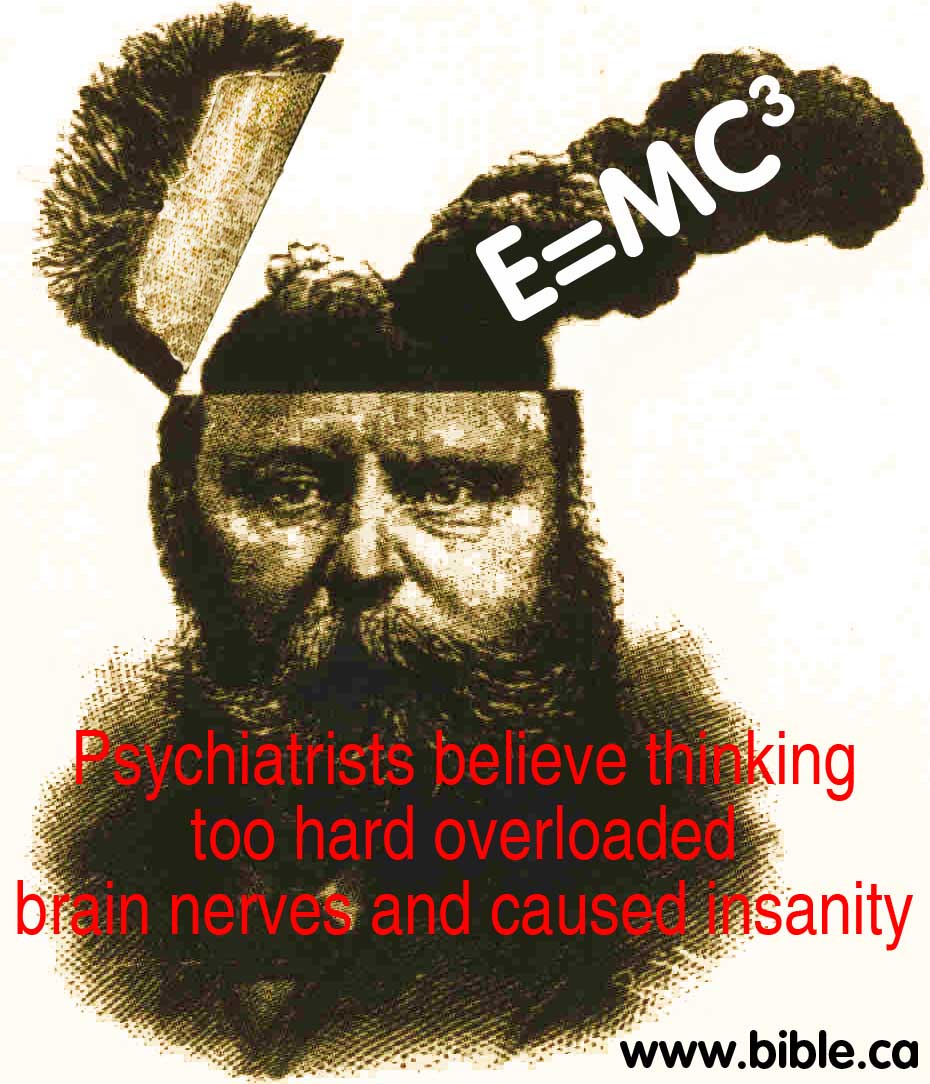
- In 1725 AD, Patrick Blair, Doctor, viewed the cause of insanity to be spiritual choices of men rather than bodily diseases. This led him to perfect a system of torture that cured the insane by waterboarding them out of insanity. It worked.
- In 1728 AD, Francis Hutcheson a naturalistic philosopher, applied Isaac's Newton's scientific laws (ie. F=MA, 1687 AD) to the human mind. Hutcheson viewed madness as the result of chemical processes and fluids inside the body. He wrongly believed that emotions were the result of chemicals floating around the blood stream. When these "fluids" were out of balance, the laws of nature inside the machine (body) were forced to obey. His quacky views are foundational to the beginning of Chemical psychiatry.
- 1729 AD, Nicholas Robinson, doctor and governor of Bedlam the same time James Monro, believed insanity was caused by life choices, sin and thinking too hard, over excitement of emotion, so as to break the nerves of the brain. He had a spiritual etiology that affected the body as well as mind.
- In 1747 AD, John Wesley, Preacher, Founder of Methodism, understood that insanity was caused by sin and noted a case of a young 20 year old man who went mad "by hearing a sermon of Mr. Wheatley's, fell into great uneasiness".
- In 1758 AD, John
Monro, doctor at the Bedlam asylum,
openly stated that he had no idea what caused mental illness: "Madness is a distemper of such a nature, that very
little of real use can be said concerning it; the immediate causes will
ever disappoint our search, and the cure of that disorder depends on management
as much as medicine."
In 1758 AD, William Battie, Mad Doctor at Bedlam and then St. Lukes asylum, stated bad nerves was a cause of madness. "When once these finest Fibres of the Brain, that immediately support the regular Exercise of our Thoughts, have suffered such a fatal Shock; no Operation of the Mind, that is regular, sedate, and uniform, can ever after be expected". - In 1761 AD, Giovanni
Battista Morgagni, doctor, decided that the etiology of madness could
be determined by, "dissecting the heads of
persons who have been disorder'd in their senses". Morgagni is
called the father of modern pathology and he dissected over 700 people of
all diseases. In his conclusions for the cause of madness, which he
believed to the same as "melancholy", he concluded it as due to,
"a considerable hardness in the brain".
Wow! That was clever! He cuts open the brain of an insane person and pokes
his finger in the dura matter. Of course he either "doctored his
research" like drug companies do today or was incompetent, because he
was wrong. The brains of the insane are the same as normal people.
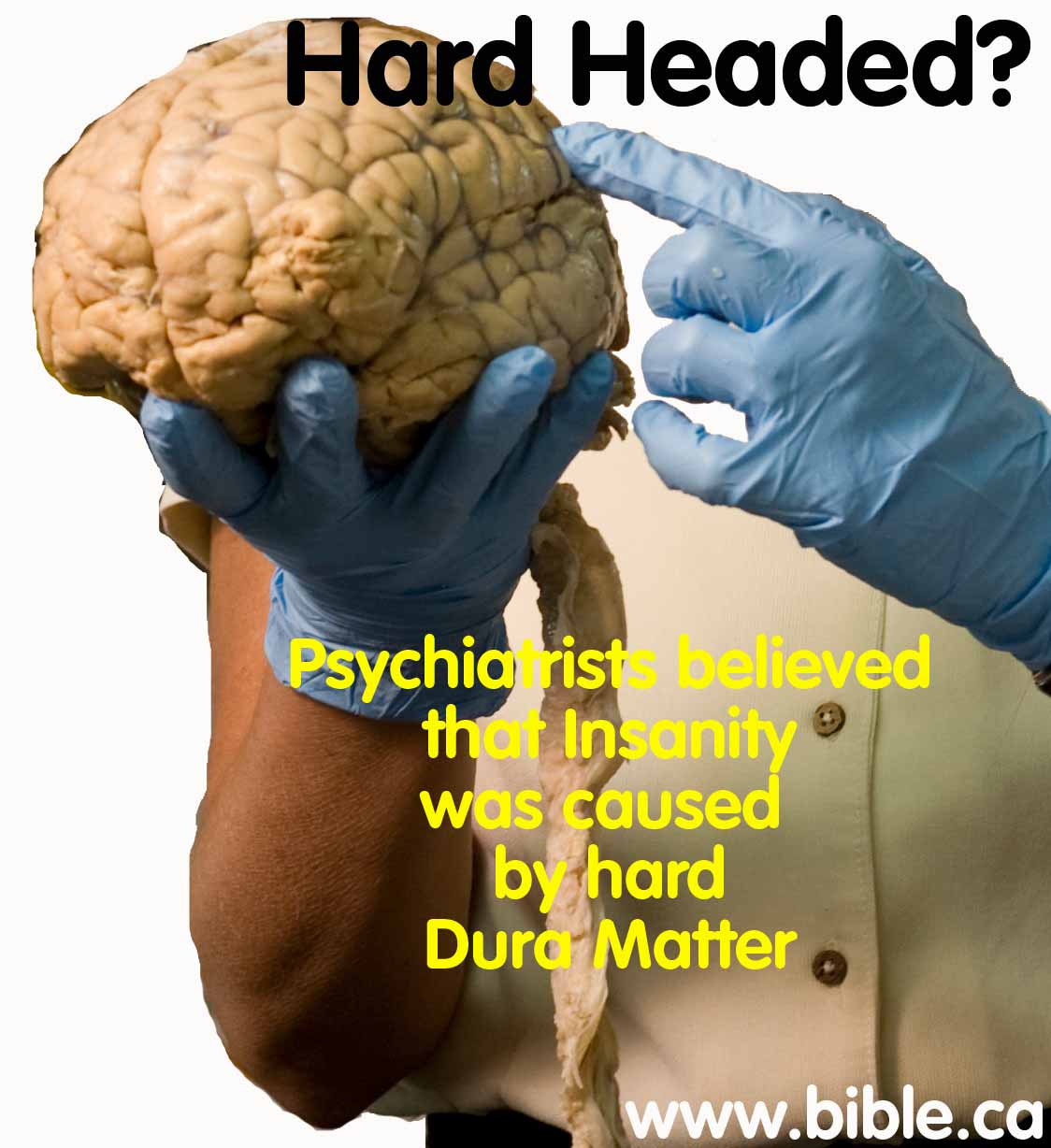
- In 1766 AD, John Hill, a doctor, believed that Hypochondriasis (depression) was induced by melancholy blood clogging the spleen. "To call the hypochondriasis a fanciful malady, is ignorant and cruel. It is a real, and a sad disease: an obstruction of the spleen by thickened and distempered blood; extending itself often to the liver, and other parts ... this obstruction in the spleen is the true malady"

- In 1775 AD, Hugh
Farmer, church minister, correctly taught that demon possession never
caused insanity. Farmer would not "ascribe
madness and epileptic fits to possession"

- In 1782 AD, Thomas Arnold, Doctor and Mad house owner described the etiology of insanity to "derive its origin from some accidental, and temporary, state . . . or to take its peculiar turn from the prevailing notions, and fashionable prejudices, of the times, or places, in which it occurs". In other words, the insane person was influenced by his environment from the outside, not some problem with brain nerves.
- In 1787 AD, William St. Clare,
doctor, wrote about a classic case of hysteria where,
"a girl put a mouse into the breast of
another girl who had a great dread of mice. The girl was immediately
thrown into a fit, and continued in it with the most violent convulsions
for 24 hours". A total 24 girls began to imitate the symptoms
and the cotton mill where they all worked was shut down for fear of a
plague that entered the factory from a bag of cotton. Clare cured them all
instantly with his electric shock machine! Here is an example of how a
form of torture, instantly snapped these girls out of their acting. The
motive was likely a combination of fun, attention and getting a few days
off work.

- In 1789 AD, J. C. Lavater trod
down the center road of typical psychiatric quackery when he equated a
persons personality and aptitude based on the shape for their face.
Madness could be seen in the face! Equally spectacularly stupid was phrenology
(Spurzheim and Gall, 1815 AD) that determined a persons personality and
aptitude based upon the shape and bumps of the scull cap. (Essays on physiognomy,
J. C. Lavater, 1789 AD)
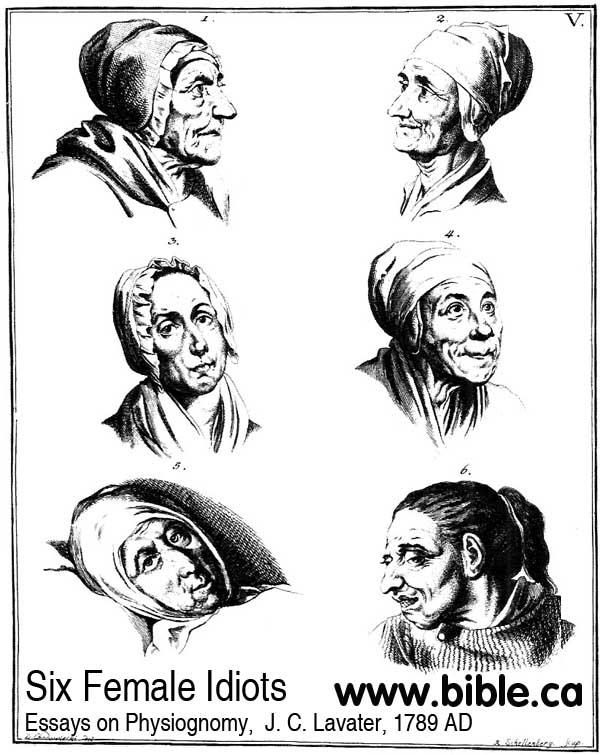
- In 1792 AD, William Pargeter, Doctor and Chaplain, cured the insane by "catching the eye" of the patient. This was not hypnotism, but simple good, caring bedside manner. Of course this proves that insanity is not some chemical imbalance in the brain where a person is unable to control themselves. Rather, the "madness" can be turned on and turned off at the will of the "madman".
- In 1803 AD, Johann
Christian Reil believed that insanity was caused by the mind and
choices people made. He rejected a physical etiology of insanity. He
practices all the moral treatments of his era. Typical of all the mad
doctors of his day, he used coercion and discipline to gain control over
the insane. He would water board, pour hot wax on the body, burn the souls
of the feet, surprise baths with live eels, sex with prostitutes to
elevate sexual insanity. But he most famous for his Cat piano
(Katzenklavier) therapy.

- In 1806 AD, Sir Charles Bell, Artist, describes how madness begins in the spirit moves to affect the body, seen in the facial expressions. "to lay a foundation for studying the influence of the mind upon the body" This is rather obvious, but in fact rejected by chemical psychiatry today, which views man as a pile of chemicals and the mind as a non-existent myth.
- In 1806 AD, Philippe Pinel,
doctor, correctly understanding that insanity was a spiritual problem, not
an organic/physical problem with the brain. He rejects the etiology that
brain legions caused insanity and identifies this error as the reason
doctors of his time also viewed the insane as incurable. This is exactly
what we see today when chemical psychiatrists view insanity as a chemical imbalance
in the brain and you labeled
for life as a mental biologic misfit. He reveals his "great and invaluable secret in the management of well
regulated hospitals" is understanding that insanity is not an
incurable organic disease, but a curable condition caused by the human
spirit "nervous excitement" which
he said affects both body and the way people think.
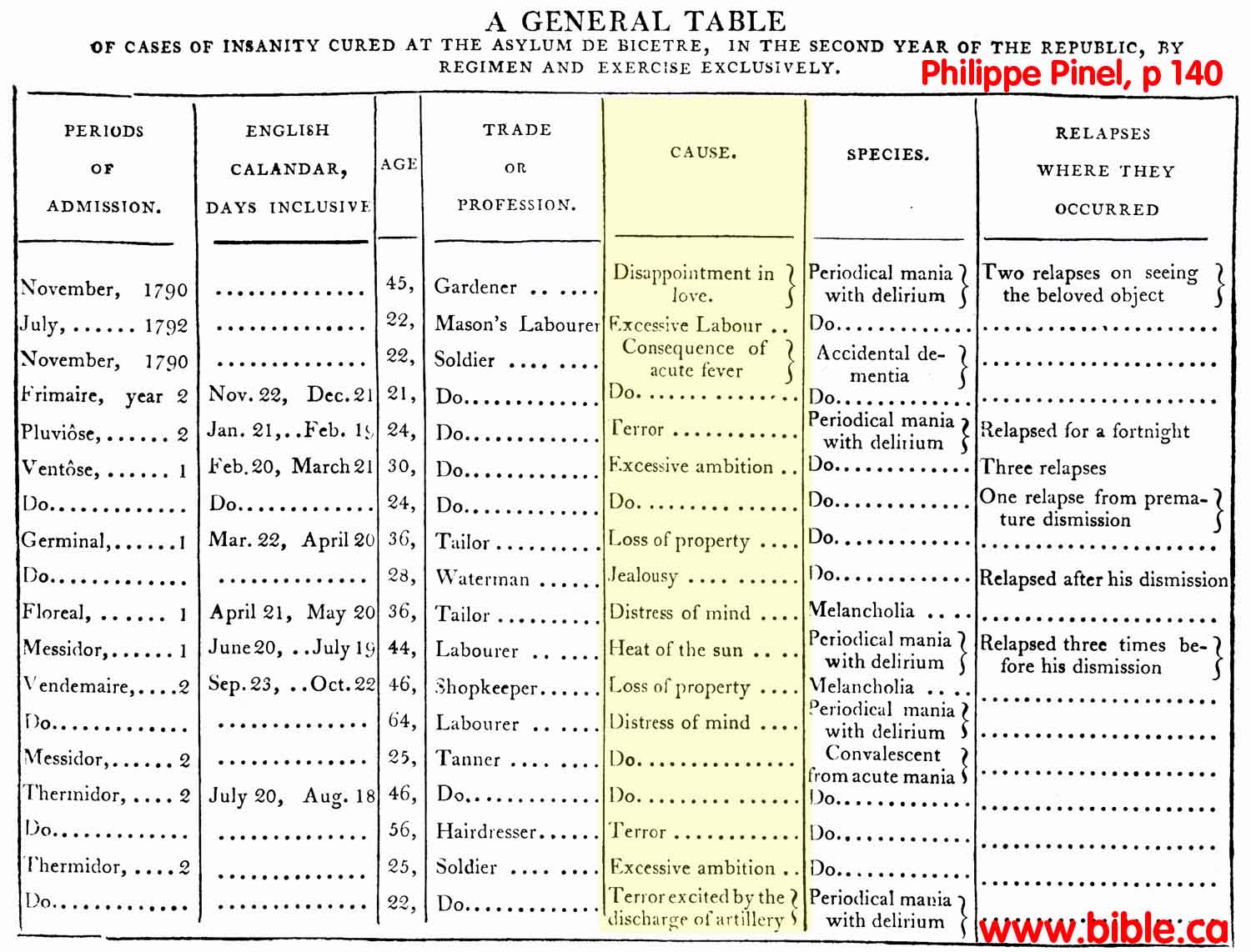
- In 1811 AD, Joseph Mason Cox, doctor, popularized a form of torture that cured insanity called "the swing" by making people feel miserable and break down their will to engage in "insane behaviors". Cox described the swing as, "both a moral [discipline] and medical mean in the treatment of maniacs."
- In 1812 AD, Benjamin
Rush, a doctor known as the "father of modern psychiatry",
believed that madness was caused by blood vessels in the brain and cured
it by threatening to kill the insane if
they did not cure themselves! Rush suffers from
"scholastic schizophrenia" because he devotes an entire section
to, "The causes which induce intellectual
derangement, by acting upon the body through the medium of the mind
... "a conscience burdened with guilt,
extravagant joy, terror, fear, public humiliation, homesickness,
unexpected losses of money, drawing high prizes in a lottery, intense
study, memorization.". From an etiological viewpoint, it is
clear that Rush believed that the human spirit through emotion, feelings
and guilt for sin actually "induced" insanity. So in one breath
he says insanity is caused by blood vessels and in the other the human
spirit. The only way to cure Rush of his "scholastic
schizophrenia" is to suggest that the human spirit affected the blood
vessels in the brain, which then caused madness. Of course his medical
views were quackery because blood vessels in the brain have nothing to do
with insanity. Rush was very aware that the choices of the human spirit,
guilt, sin and circumstances were the real etiology of madness.
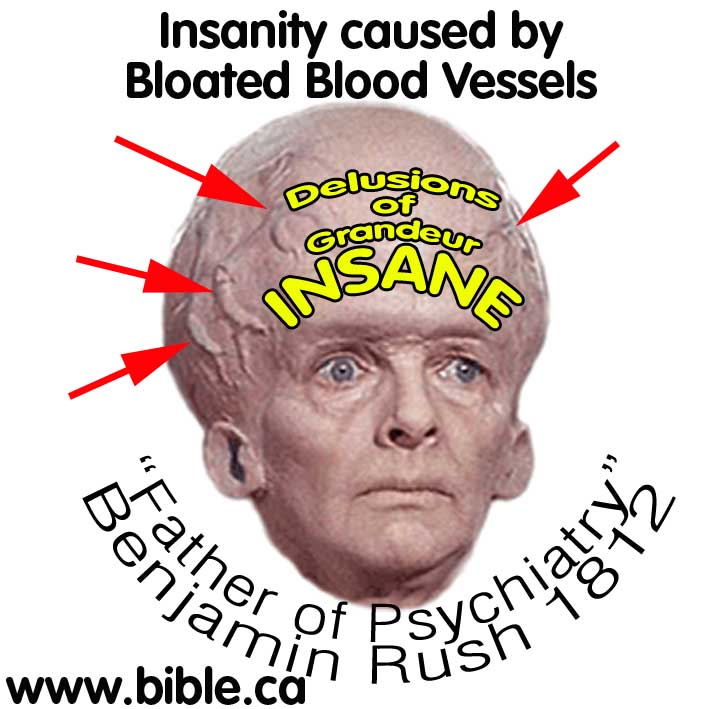

- In 1813 AD, Samuel Tuke, minister for Quakers, devoted his life to the Retreat for the insane at York. Although he was unsure if the cause of insanity was spiritual/mind, or physical/body, but he strongly leaned towards the spiritual/mind etiology. "If we adopt the opinion, that the disease originates in the mind, applications made immediately to it, are obviously the most natural; and the most likely to be attended with success. If on the contrary, we conceive that mind is incapable of injury or destruction, and that, in all cases of apparent mental derangement, some bodily disease, though unseen and unknown, really exists, we shall still readily admit... In the present imperfect state of our knowledge, of the very interesting branch of the healing art, which relates to the cure of insanity; and unable as we generally are to ascertain its true seat in the complicated labyrinths. He made a powerful disclaimer against those who believed insanity was a physical disease: "We are, however, far from adopting it as a universal maxim, that maniacal symptoms are aggravated by bodily disorder." Most important, he believed the insane never lost their self control or freewill in action. "that madness, in all its forms, is capable of entire control". The fundamental concepts Tuke used in the treatment of the insane were their inherent ability to exercise self control because insanity was a spiritual problem, not bodily disease. All of Tuke's treatments (attending church, kindness, coercion, warm baths, humiliation) pointed to the fact that he correctly suspected insanity was not a bodily disease, but caused by life choices and circumstances. (Description Of The Retreat For Insane, Samuel Tuke, 1813 AD)
- In 1815 AD, Franz
Joseph Gall and Johann
Gaspar Spurzheim came up with a new and improved version of the
junk-pop psychology theories of Lavater's physiognomy,
who taught the shape of a persons skull determined their mental abilities.
Phrenology
taught that the shape and size of the joints between the 22 bones of the
human skull, determined all mental and personality traits. This tradition
of quack psychiatry continues today with the God
Helmet in 2002 AD, where magnetic impulses on the side of the are
supposed to generate spiritual experiences in the wearer. Poor gullible
atheist Richard
Dawkins actually tried on the God Helmet. How else could he expect to
see God? So the stupid junk science of phrenology has a dark tradition
that continues into modern chemical psychiatry. Gall taught that since a
person's mental and moral characteristics are determined by the shape of
the skull he was born with, criminals really couldn't be blamed for their
crimes. This thinking is seen today in the insanity
plea and chemical
evolutionary psychiatrists.
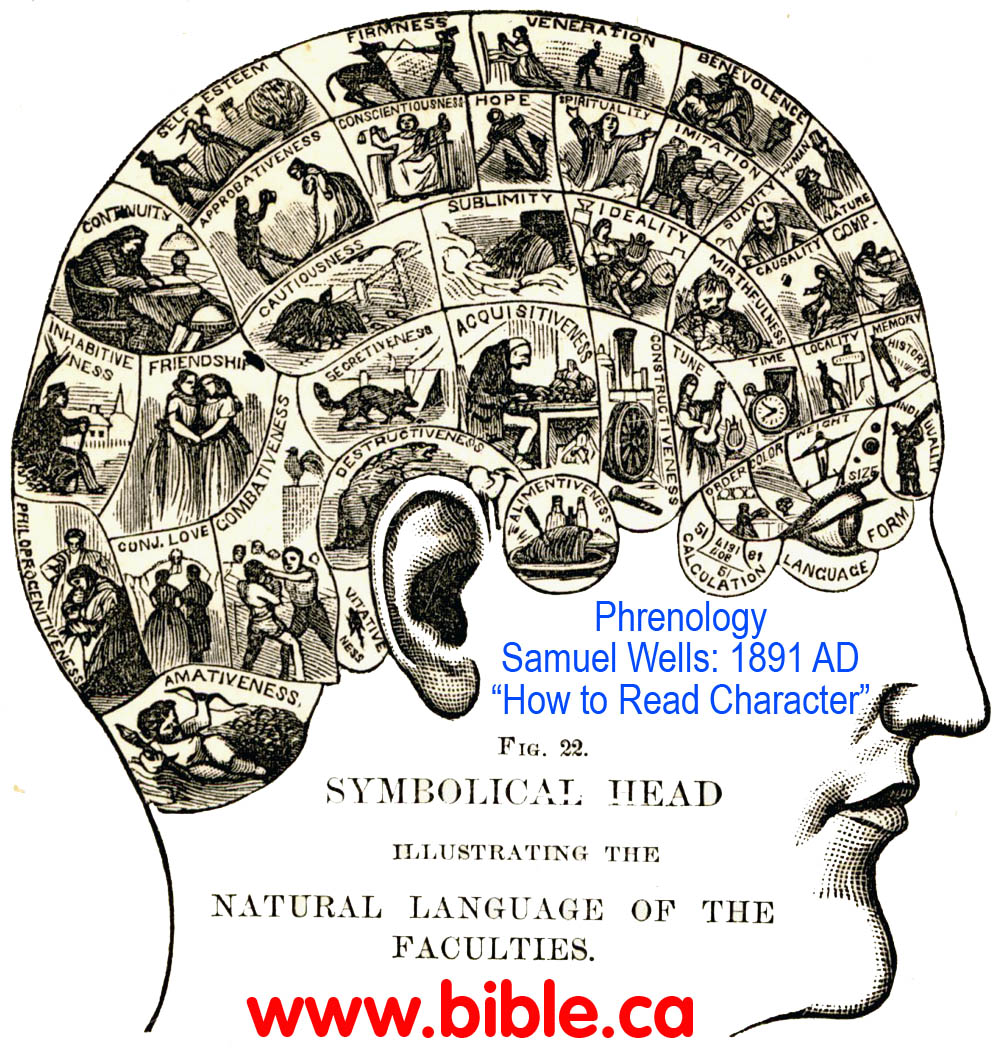
- In 1818 AD, William Saunders Hallaran, Doctor, understood that insanity was a moral choice cured by persuasion of the "swing": "from repeated trials, I can confidently declare, that its efficacy ... appears to be incontrovertibly ascertained ... This method of subduing furious maniacs, has succeeded in an admirable manner ... I have generally found patients to become at once so subservient to my wishes, as willingly to take any medicine prescribed." And it worked, proving that mental illness is not a bodily disease, but a moral choice of the madman within his power to control and change. Incurables were those who did not respond to any known treatment, yet the chair cured them!
- In 1818 AD, Johann
Christian August Heinroth, Doctor and Christian, invented the term
"psychosomatic". He clearly stated that insanity was not a
bodily illness, but a spiritual choice that violates the conscience that
is caused by sin. He rejected all the humoral the causes that other
doctors believed caused insanity. Heinroth adopts the Christian view that
man has a distinct body and soul: "Our inner
being, or our inner I, is our soul, while our external Self is our body."
Heinroth understood that often, there was nothing physically wrong with
the insane. He places the blame for those who are insane squarely upon
themselves, their personal choices and self deception: Heinroth understood
that the mind can make the body sick and the body can affect the way one
feels, he believed that in the majority of cases, insanity was caused by
the soul alone. He states that sin is the etiology of madness and that
being insane is actually a sinful state itself like "living common
law". Thus he sees all insane as lost souls to the Devil. It
important to remember that he also rejected demon possession as a cause of
insanity: Heirnroth, as a Christian, sees a loving God calling a rebellious
man to himself. When man on the basis of his own free will rejects God,
sometimes the result is insanity. This is the foundation of his etiology
of madness.

- In 1828 AD, Sir Alexander Morison, doctor, understood that insanity was not a bodily disease but a spiritual choice that could be altered by Water treatment and the Swing. The fact they were so widely used and indeed cured the insane, is historic proof that mental illness is not a bodily disease or chemical imbalance in the brain, but a spiritual choice made by the "patient".
- In 1835 AD, James Cowles Prichard, Doctor, pioneered , the idea of "moral insanity" (to the detriment of mankind) so that criminals would not pay for their crimes. As the term "moral insanity" infers, a disease of the body causes someone to commit immoral acts (crimes) without any traces of delusion, paranoia or schizophrenia. In a page out of modern chemical psychiatry, Prichard ascribes as many different kinds of moral insanity as sins listed in the Bible: "the varieties of moral insanity are perhaps as numerous as the modifications of feeling or passion in the human mind" So Prichard has moral insanity varieties like "theft", "murder", "ponzi stock market scheming" etc. Prichard, like psychiatrists today, believed that insane people were forced to commit crimes like mal-adjusted chemical robots. Prichard believes that it is the disease forcing the sinful behaviour upon an otherwise model citizen.
- In 1853 AD, Robert Brudenell Carter, world renounced ophthalmologist, wrote his first book on hysteria and faking insanity. Having concluded much of insanity was pure faking, he lost interest in psychiatry and specialized in eye surgery. Carter recognized that the physical symptoms were caused by the power of the mind. It is clear that Carter viewed hysteria as a blatant and deliberate deception where a person acts like they are insane or sick in order to gain sympathy, attention or be excused from life's responsibilities and be catered to. Like many medical students today who consider a career in psychiatry, see it for the deceptive confusion it really is, then chose to specialize in a real medical career, Carter left psychiatry and became a world class eye surgeon. His book on hysterics should have been the writing on the tombstone that exposed insanity for what it really is and psychiatry as quackery and junk pseudo science. But the Devil was raising to power, two of his demon angels: Sigmund Freud and Charles Darwin's Origin of the Species in 1859 AD. The result is the chemical psychiatry we see today.
- In 1857 AD, Richard Robert Madden observed many historic cases of a kind of mass hysteria. What is interesting about this phenomena, is that it is clearly induced by freewill choices of the minds of a large number of people at the same time. This proves that such mass delusions and hallucinations are not caused by the body, but the mind. Madden understood that if the mind of a single person could induce insanity, so could it happen on a mass scale.
- In 1857 AD, Alexandre
J. F. Brierre De Boismont, doctor, viewed hallucinations as the
product of the human mind and cured by cold baths and cold water torture.
Suggesting that both insanity and hallucinations are entirely products of
the mind and not the body is a stunning contradiction to chemical
psychiatry today, but this view was actually the historically majority
view. He used cold water dripping on the head to cure insanity: "The
effect produced by this continued sprinkling has, first, the advantage of
keeping up a constant cooling effect on the organ which is congested,
without causing those injurious results which have been laid to the charge
of ice. In the second place, it harasses the
patient" Although Boismont's
etiology of "melancholy blood" was junk Hippocratic science, he
clearly understood that people could be tortured into sanity.
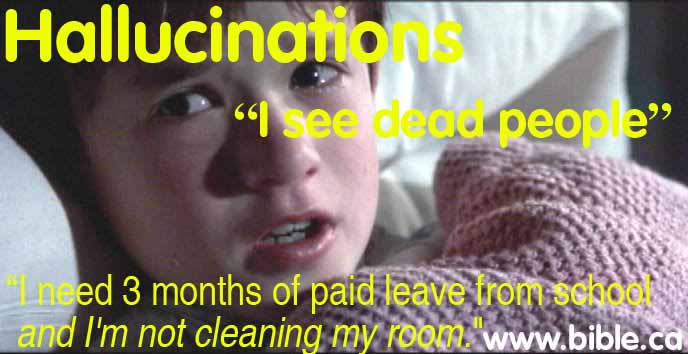
Conclusion:
- Historically, the etiology (cause) of insanity was viewed in one of three ways: 1. Most believed that sin, life choices and circumstances directly caused insanity. 2. Some believed sin, life choices and circumstances indirectly caused insanity by first producing melancholy blood, which then caused insanity. Worry, guilt, anger fear, etc, affected the body, which then caused insanity. 3. A tiny minority believed insanity was a random bodily illness like any other physical disease. Like chemical psychiatrists today, they rejected the idea that life choices and circumstances had anything to do with insanity.
- Although these doctors had a totally incorrect "humoralistic view" of medicine, their observations on the causes of mental illness were generally correct!
- Their treatments, were designed to punish, motivate, and change the will of the insane.
- Here is a survey of the historic treatments mad doctors used on the insane.
By Steve Rudd: Contact the author for comments, input or corrections.
Send us your story about your experience with modern Psychiatry

